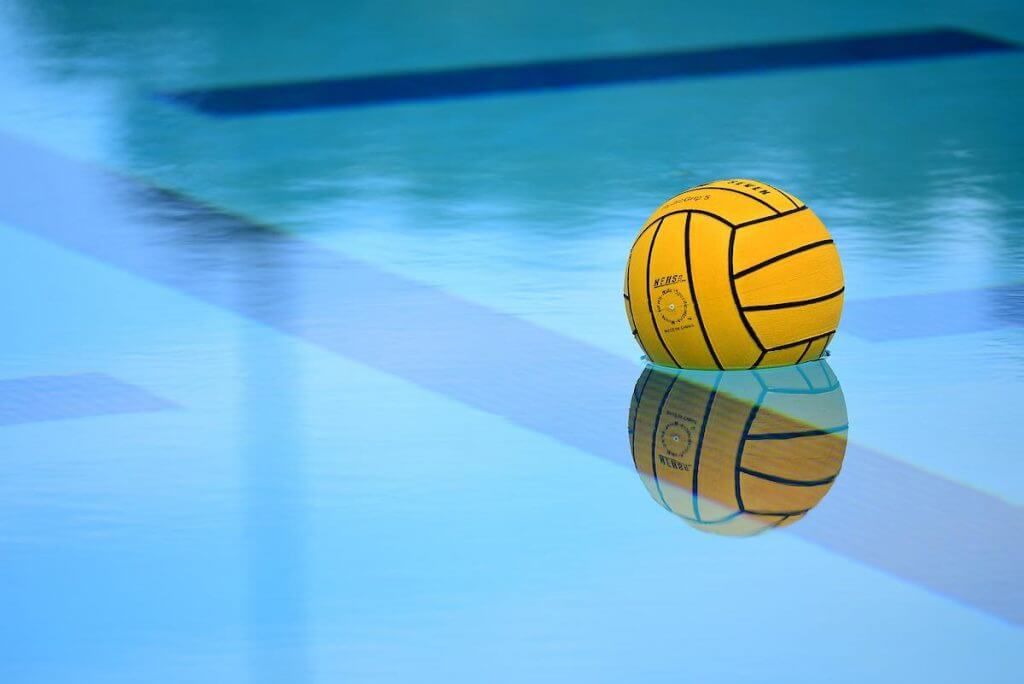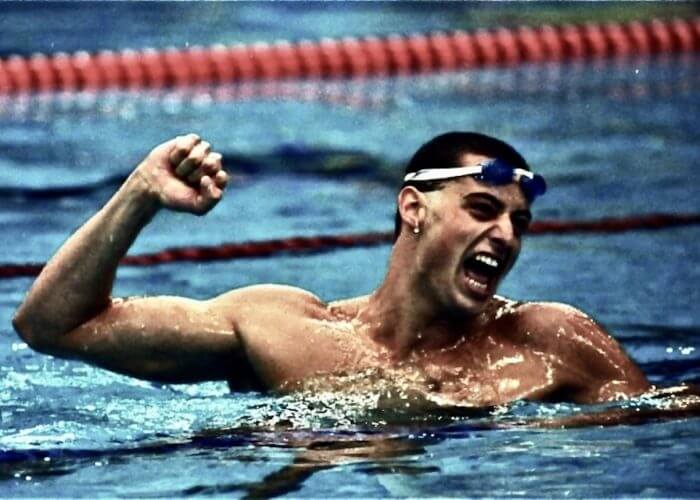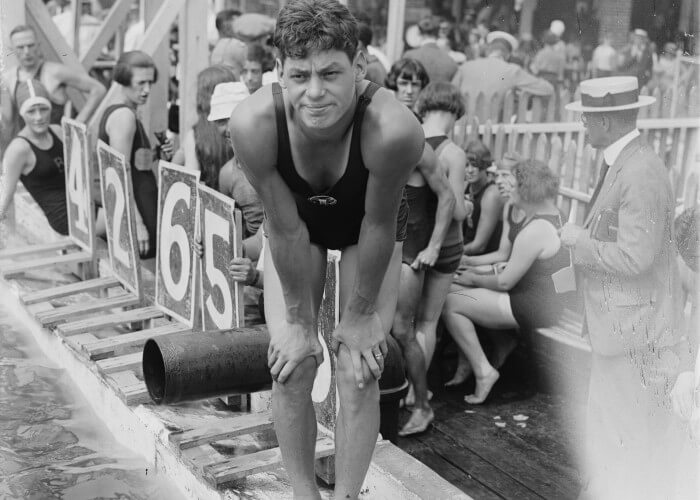The Century of the Elite Water Polo/Swimming Dual-Sport Athlete

The Century of the Elite Water Polo/Swimming Dual-Sport Athlete
By Jeff Moulton and Russ Hafferkamp
In the 20th century, it was not uncommon for American male athletes to excel in both water polo and swimming. Indeed, several of the top ten American male swimmers were excellent water polo players and dozens of American athletes were Olympians in water polo or swimming and at least a Division I All-American in the other sport. On the other hand, since 2001, no American athlete has been an Olympian in water polo or swimming and at least a Division I All-American in the other sport. In Part One of this article, we consider the relationship between high-level swimming and water polo in the United States in the 20th century. In Part Two, we will discuss the factors that have led to the sharp decline in the number of athletes who excel in both sports.
Background
Water polo and competitive swimming share a number of things in common. For example, water polo and competitive swimming generally require strong swimming skills, endurance, leg strength, perseverance, and mental discipline, and take place in a swimming pool. In addition, most American water polo players and competitive swimmers come from an upper-middle class background.
Competitive swimming can trace its roots to the early 1800s. Water polo was introduced into the United States in 1888 and became an Olympic sport in 1900. The United States won the gold medal in the 1904 Olympics in St. Louis, Missouri, but that gold medal comes with a large asterisk because only three teams (all from the United States) participated in water polo. Other than 1904, the United States men’s water polo team has never won a gold medal (the United States women’s team is seeking its fourth consecutive gold medal in this summer’s Paris Olympics).
The broad growth of water polo in the United States has mostly occurred in recent times. Many people believe the “modern era” of men’s water polo in the United States began in the 1960s when most of the top California high school water polo programs in Orange County, Los Angeles County, Northern California, and San Diego were established and water polo became an official NCAA men’s sport in 1969.
Prior to the mid-1960s, American water polo was dominated by club teams from cities such as New York, San Francisco, Los Angeles, and Chicago. Before 1968, American Olympic water polo teams were comprised largely of players from the club team that had won the most recent United States national championship. The selection process for the Olympics changed in the mid-1960s when United States water polo officials established a national team and athletes competed for spots on the team.
In the 20th century, most water polo coaches thought (correctly) that swimming provided excellent training for water polo players. Many of the top water polo coaches were also swim coaches. For example, three of the top four 20th century college water polo coaches (Cal’s Pete Cutino, UCLA’s Bob Horn, and U.C. Irvine’s Ted Newland) were college swim coaches. While at Cal, Cutino coached seven players who later became members of the Water Polo Hall of Fame. Five of the seven players were also members of Cal’s swim team. In addition, many 20th century swim coaches thought that water polo provided excellent training for competitive swimmers, including George Haines, considered by many to be the greatest swim coach of the 20th century. Bob Duenkel, former Executive Director of the International Swimming Hall of Fame, said this about Haines:
“George helped promote all the aquatic disciplines and, in particular, recommended water polo as a training and competitive supplement for his swimmers.”
In addition to coaching the swim team at Santa Clara High School, Haines coached the water polo and football teams. Two of America’s greatest swimmers, Mark Spitz and Don Schollander, swam for Haines at Santa Clara High School and were high school All-American water polo players.
Although year-round youth swim clubs have been in existence in the United States for a long time, there weren’t many year-round youth water polo clubs before the 2000s. For much of the 20th century, top high school water polo players typically played high school water polo in the fall and club water polo in the summer, leaving them free to swim or play other sports during the rest of the year.
American Athletes Excelling in Both Water Polo and Swimming
The close relationship between swimming and water polo throughout the 20th century helps explain why a number of American athletes excelled in both sports. For example, consider the following hypothetical “all-star” teams comprised of athletes who played water polo and swam at elite levels during the 20th century.
“All-Star” Water Polo and Swim Team from the 1960s through 2000
To qualify for this team, an athlete had to be an Olympian in water polo or swimming and at least a Division 1 All-American in the other sport.
Jon Svendsen – Miramonte High School and Cal; NCAA POY; 2x water polo Olympian, winning a silver medal in 1984; would have been a 3x Olympian if the United States had qualified for the 1976 Olympics; Water Polo Hall of Fame; 2x swimming All-American.
Stanley Cole – Whittier High School and UCLA; 3x water polo Olympian (1964, 1968, and 1972), winning a bronze medal in 1972; Water Polo Hall of Fame; 3x swimming All-American; set an NCAA swimming record.
Roy Saari – El Segundo High School and USC; played on seven AAU senior national championship water polo teams; Water Polo Hall of Fame; NCAA swimmer of the year in 1965; 1x Olympian in swimming (1964), winning one gold medal and one silver medal; set four world records; inducted into the International Swimming Hall of Fame as a swimmer. Saari was a member of the United States water polo team that qualified for the 1964 Olympics and he also qualified for the Olympic swim team. In 1964, athletes were not allowed to participate in two sports at the Olympics. Saari chose to be on the swim team.
Russell Webb – Fullerton High School and UCLA; 2x water polo Olympian (1968 and 1972), winning a bronze medal in 1972; Water Polo Hall of Fame; 3x swimming All-American; set 2 NCAA swimming records and one American record.
Dave Ashleigh – Whittier High School, Cerritos Community College, and UCLA; 2x water polo Olympian (1964 and 1968); Water Polo Hall of Fame; 2x swimming All-American.
Peter Schnugg – Miramonte High School and Cal, NCAA POY, 1x water polo Olympian (1980) and would have been a 2x Olympian if the United States had qualified for the 1976 Olympics, Water Polo Hall of Fame, 2x swimming All-American.
Gary Sheerer – Awalt High School and Stanford; 2x water polo Olympian (1968 and 1972), winning a bronze medal in 1972; Water Polo Hall of Fame; set the NCAA freshman record in the 200-yard freestyle, the record was first broken by Don Schollander.
Brad Schumacher – Bowie High School and Pacific; 1x water polo Olympian (2000); 1x swimming Olympian (1996), winning two gold medals in relay events.

Matt Bioni – Photo Courtesy: ISHOF
Matt Biondi – Campolindo High School and Cal; 3x NCAA water polo champion; 4x water polo All-American; 3x Olympian in swimming (1984, 1988, and 1992), winning 11 medals (8 gold, 2 silver, and 1 bronze); set 11 world records in individual swimming events; inducted into the International Swimming Hall of Fame as a swimmer. The International Swimming Hall of Fame contains this note about Biondi’s background in swimming and water polo: “His high school coach, Stu Kahn, encouraged both sports. The combination over the years kept him mentally sharp for both competitions, and he calls his relatively late start in year-round competitive swimming and his great love for water polo, the combination that kept him from burning out.”
Steve Furniss – Foothill High School and USC; 2x water polo All-American; 2x swimming Olympian (1972 and 1976), winning a bronze medal in the 200-meter individual medley in 1972; set two world records.
Tim Shaw – Long Beach Wilson High School, LBSU, and Arizona; 1x water polo Olympian (1984), winning a silver medal; Water Polo Hall of Fame; 1x swimming Olympian (1976), winning a silver medal in the 400-meter freestyle; set 10 world records; named the World Swimmer of the Year in 1974 and 1975; inducted into the International Swimming Hall of Fame as a swimmer.
Dean Willeford – Downey High School and USC, 1x water polo Olympian (1968), Water Polo Hall of Fame, All-American swimmer in multiple events.
Paul Becskehazy – El Segundo High School and UCLA, 3x water polo All-American, would have been on the 1976 Olympic team if the U.S. had qualified for the Olympics that year, member of the Brazilian 400-meter freestyle relay team that finished fourth in the 1972 Olympics.
Robin Leamy – Rolling Hills High School and UCLA; 2x All-American in water polo; 1x Olympian in swimming (1984), winning a gold medal in the 400-meter freestyle relay; former world record holder in the 50-yard and 50-meter freestyle.
Monte Nitzkowski – coach; Huntington Beach High School, Fullerton Junior College, and UCLA; 3x Olympic water polo coach (1972, 1980, and 1984), winning a bronze medal in 1972 and a silver medal in 1984 (the United States was a co-favorite to win the gold medal in 1980 but President Carter decided to boycott the 1980 Olympics); Water Polo Hall of Fame; All-American in swimming in both of his years at UCLA; 1x Olympian in swimming (1952); inducted into the International Swimming Hall of Fame as a water polo coach.
Pre-1960s “All-Star” Water Polo and Swim Team
Given the attitude of many water polo and swim coaches prior to 1960, it’s not surprising that a number of early 20th century American athletes excelled in both sports. For example, consider this “all-star” team comprised of 15 athletes who excelled in both sports before 1960. To qualify for this team, an athlete had to have been an Olympian in water polo or swimming and to have excelled in the other sport.
Wally O’Connor – Venice High School and Stanford; probably the greatest American water polo player of the first half of the 20th century; 4x water polo Olympian (1924, 1928, 1932, and 1936), winning two bronze medals; would have been on the 1940 Olympic team if the Olympics had not been cancelled that year because of World War II; Water Polo Hall of Fame; 1x swimming Olympian (1924), winning a gold medal and setting the world record in the 800-meter freestyle relay; inducted into the International Swimming Hall of Fame as a water polo player.
Bob Horn – Whittier High School, Fullerton Junior College, and Long Beach State; 2x water polo Olympian, winning a bronze medal in 1960; considered to be the best goalie of his era; UCLA’s water polo coach from 1963 through 1990; Water Polo Hall of Fame; UCLA’s swim coach for 12 years; 2x community college swimming All-American.
Bob Hughes – El Segundo High School, El Camino Community College, and USC; 2x water polo Olympian (1952 and 1956); Water Polo Hall of Fame; 1x swimming Olympian (1956); set a world record in the 100-yard breaststroke.
Wally Wolf – Beverly Hills High School and USC; 2x water polo Olympian (1956 and 1960); Water Polo Hall of Fame; 2x swimming Olympian (1948 and 1952), winning two gold medals and setting a world record in the 800-meter freestyle relay.

Johnny Weissmuller – Photo Courtesy: ISHOF
Johnny Weissmuller – emigrated to the United States from Hungary; generally considered to be the greatest swimmer of the first half of the 20th century; 1x water polo Olympian (1924), winning a bronze medal; 2x swimming Olympian (1924 and 1928), winning five gold medals; set 51 world records; inducted into the International Swimming Hall of Fame as a swimmer; played Tarzan in 16 movies.
Duke Kahanamoku – Kamehameha High School; 1x water polo Olympian or alternate; 3x swimming Olympian (1912, 1920, and 1924), winning three gold medals and two silver medals; would have been on the 1916 Olympic team if the Olympics had not been cancelled that year because of World War I; set multiple world records; inducted into the International Swimming Hall of Fame as a swimmer.
Harry Hebner – Central YMCA high school in Chicago; 1x water polo Olympian (1920); Water Polo Hall of Fame; 3x swimming Olympian (1908, 1912, and 1920), winning a gold, silver, and bronze medal; would have been on the 1916 Olympic team if the Olympics had not been cancelled that year because of World War I; set multiple world backstroke records; inducted into the International Swimming Hall of Fame as a swimmer.
Ray Ruddy – All-Hollows High School and Columbia; 2x water polo Olympian (1932 and 1936), Water Polo Hall of Fame, 1x swimming Olympian (1928), died in an accident at the age of 27.
Turk McDermott – Lake High School and De La Salle Institute, 1x water polo Olympian (1920), Water Polo Hall of Fame, 2x swimming Olympian (1912 and 1920), would have been on the 1916 Olympic team if the Olympics had not been cancelled that year because of World War I, inducted into the International Swimming Hall of Fame as a swimmer.
Perry McGillivray – Crane Tech High School and Illinois; 1x water polo Olympian as a player (1920); 1x water polo Olympian as a coach (1928); Water Polo Hall of Fame; 2x swimming Olympian (1912 and 1920), winning a silver medal in the 800-meter freestyle relay in 1912 and a gold medal in the 800-meter freestyle relay in 1920; would have been on the 1916 Olympic team if the Olympics had not been cancelled that year because of World War I; set one world record; inducted into the International Swimming Hall of Fame as a swimmer.
George Schroth – Sacramento High School and St. Mary’s college in Moraga; 2x water polo Olympian (1924 and 1928), winning a bronze medal in 1924; Water Polo Hall of Fame; won several Pacific Coast 50 and 100-freestyle swimming titles.
Chuck Bittick – Long Beach Wilson High School, Long Beach City College, and USC; 1x water polo Olympian (1960); Water Polo Hall of Fame; 3x swimming All-American; won four NCAA swimming titles; held the world record in the 200-meter backstroke.
Hal Vollmer – Stuyvesant High School and Columbia; 2x water polo Olympian (1920 and 1924), winning a bronze medal in 1924; Water Polo Hall of Fame; would have been on the 1916 Olympic swim team if the Olympics had not been cancelled that year because of World War I; held the world record in multiple events; inducted into the International Swimming Hall of Fame as a “pioneer swimmer.”
Jack Spargo – El Segundo High School, Cal, and UCLA; 1x water polo Olympian (1952); Water Polo Hall of Fame; swimming All-American.
Jim Gaughran – Sequoia High School and Stanford, 1x water polo Olympian (1956), water polo coach at Stanford from 1969 through 1973, Water Polo Hall of Fame as a player, 2x swimming All-American, swim coach at Stanford from 1960 through 1979, inducted into the International Swimming Hall of Fame as a swim coach.
What Happened to the Elite Water Polo/Swimming Dual-Sport Athletes?
In Part Two of this article, we will discuss the factors that have led to the virtual disappearance of athletes who excel in both water polo and swimming.
Russ Hafferkamp is a member of the Water Polo Hall of Fame and Jeff Moulton is a longtime aquatics fan.




Where is Marty Hull’s name. Shouldn’t it be here ??